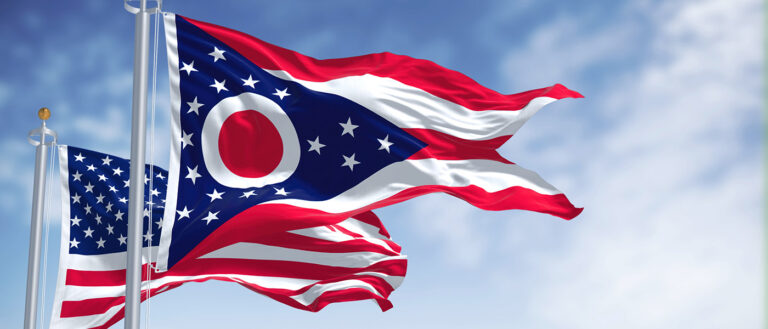Anticipation is high as Americans cast their ballots in the Nov. 5 General Election to determine the next president and vice president of the United States. Amidst an overwhelming influx of political ads, people are sure to look for trends or polls to help predict results.
“Swing states” have been one such measuring stick over the years. Also known as “battleground” or “purple” states, these states represent roughly equal numbers of registered Democrats (blue) and Republicans (red), making them enticing settings for political campaigns to try to sway voters.
Ohio has been one such swing state in past elections, serving as an influential bellwether in presidential elections from 1980 onward. But the majority of the state has voted red in major elections since 2016—a result suggesting a change in the Buckeye State’s underlying politics.
To better understand Ohio’s status looking ahead, The Daily spoke with Justin Buchler, associate professor in the Department of Political Science at the College of Arts and Sciences. Buchler studies elections, political parties and Congress.
Read on to learn his thoughts.
Q: Where did the concept of a “swing state” come from?
Buchler: Before modern polling, one could only look at past election results [to predict outcomes]. Because one election may differ from the previous election, the introduction of polling in the 20th century permitted narrow targeting within presidential elections. This began when political questions were added on to marketing surveys and, eventually, firms found ways to build either academic, journalistic or consulting surveys separately from marketing.
As the press started to focus more on the horse-race aspect of presidential elections throughout the latter half of the 20th century, they conducted more polls, while the candidates and parties hired firms to perform surveys in order to guide campaign strategy. The term “swing state,” itself, is merely a convenience.
Q: How has Ohio’s political identity evolved over the decades?
Buchler: There is not, and never has been anything special about one state, Ohio included. For many years, Ohio had a balance of Democrats and Republicans that reflected the nation. As a consequence, in the years when the nation shifted toward the Democrats, so did Ohio. When the country shifted toward the Republicans, so did Ohio. Combined, that meant Ohio tended to vote the way the nation voted.
The misinterpretation was that Ohio picked the winner, but that’s backward. Whenever the nation swung toward a party, that was the direction Ohio moved for the same reason, with the following caveat: In the close elections, you can array the states from most strongly Democratic to most strongly Republican. When the country was 50/50, Ohio had tended to be 50/50, so whatever tipped the nation tended to tip Ohio, making Ohio “pivotal,” in technical terms. If, for example, the Republicans won Ohio but no state to the left of Ohio, it is not that Ohio was magic. If the GOP could have won a more Democratic state than Ohio but not Ohio, they still would have taken the White House, had Ohio been pivotal. It’s just that this would have been politically impossible because party identification is the underlying determinant.
In the last several election cycles, Ohio has shifted to the Republican Party, so its partisan balance no longer mirrors the country. It is more heavily Republican, so the GOP can win Ohio and still lose the election, as occurred in 2020. It is sufficiently close that a Democrat can win, statewide, under favorable conditions (such as having an incumbency advantage), but the partisan balance has shifted, which happens over time.
Q: How have campaign strategies from major political parties adapted to Ohio’s shifting political climate?
Buchler: Campaign strategy has less impact than pundits, journalists and activists believe. Most votes are determined by party identification, and that means they are not moved by ads, speeches, or anything of the sort. Fundamentally, the partisan balance in Ohio is shifting, based on demography and demographic reactions to modern polarization. Ideology does influence election results, to some degree, and candidates’ political positioning matters, to some degree.
The question is how the parties are responding to the changing nature of Ohio. The Democrats, plainly, are not. They continue to move to the extremes, just as Republicans do. However, in Ohio, that is to Democrats’ detriment.
Q: What role do changes in election laws and voting procedures in Ohio play in shaping voter turnout and engagement?
Buchler: Laws on voter registration and related policies have almost no effect. When George W. Bush’s administration started pushing [Former United States Attorney General] Alberto Gonzales to investigate and prosecute cases of voter fraud, the GOP began to introduce policies on voter registration, voter ID and related changes. Democrats began making predictions, none of which came true.
We can compare the states that have instituted such policies to the states that did not, look for differences, and we find little of interest. The reasons are simple.
First, voting is habitual. Those who vote in one election tend to vote in the next, so changes to voter registration, voter purges and such policies do not matter much. Second, not many people lack proper identification. Those who do are the least likely to vote, and acquiring such documentation is quite simple. In a move-countermove sense, even if one were to attribute bad intent to the policies, which is not justified, the countermove is so simple as to make the first move functionally irrelevant. Hence, when we examine the differences across states and from year to year, none of the apocalyptic predictions about voter ID or voter registration ever came true. Apocalyptic predictions rarely do.

